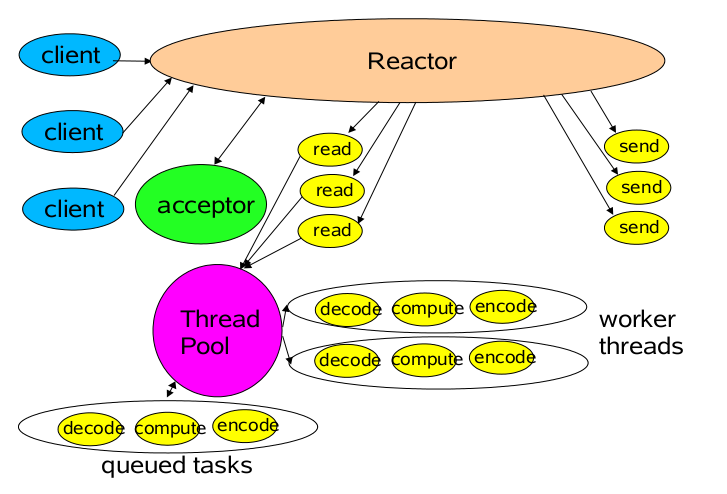【转】反应器(Reactor)模式
概述
Java NIO非堵塞技术实际是采取反应器模式,或者说是观察者(observer)模式为我们监察I/O端口,如果有内容进来,会自动通知我们,这样,我们就不必开启多个线程死等,从外界看,实现了流畅的I/O读写,不堵塞了。
同步和异步区别 : 有无通知(是否轮询)
堵塞和非堵塞区别 : 操作结果是否等待(是否马上又返回值),只是设计方式的不同。
NIO 有一个主要的类Selector,这个类似一个观察者,只要我们把需要探知的SocketChannel告诉Selector,我们接着做别的事情,当有事件发生时,他会通知我们,传回一组SelectionKey,我们读取这些Key,就会获得我们刚刚注册过的SocketChannel,然后,我们从这个Channel中读取数据,接着我们可以处理这些数据。
反应器模式与观察者模式在某些方面极为相似:当一个主体发生改变时,所有依属体都得到通知。不过,观察者模式与单个事件源关联,而反应器模式则与多个事件源关联 。
一般模型
我们想象以下情形:长途客车在路途上,有人上车有人下车,但是乘客总是希望能够在客车上得到休息。
传统的做法是:每隔一段时间(或每一个站),司机或售票员对每一个乘客询问是否下车。
反应器模式做法是:汽车是乘客访问的主体(Reactor),乘客上车后,到售票员(acceptor)处登记,之后乘客便可以休息睡觉去了,当到达乘客所要到达的目的地后,售票员将其唤醒即可。

import java.io.IOException; import java.net.InetAddress; import java.net.InetSocketAddress; import java.nio.channels.SelectionKey; import java.nio.channels.Selector; import java.nio.channels.ServerSocketChannel; import java.util.Iterator; import java.util.Set; /** * 反应器模式 用于解决多用户访问并发问题 * * 举个例子:餐厅服务问题 * * 传统线程池做法:来一个客人(请求)去一个服务员(线程) * 反应器模式做法:当客人点菜的时候,服务员就可以去招呼其他客人了,等客人点好了菜,直接招呼一声:服务员 * * @author linxcool */ public class Reactor implements Runnable { public final Selector selector; public final ServerSocketChannel serverSocketChannel; public Reactor(int port) throws IOException { selector = Selector.open(); serverSocketChannel = ServerSocketChannel.open(); InetSocketAddress inetSocketAddress = new InetSocketAddress( InetAddress.getLocalHost(), port); serverSocketChannel.socket().bind(inetSocketAddress); serverSocketChannel.configureBlocking(false); // 向selector注册该channel SelectionKey selectionKey = serverSocketChannel.register(selector, SelectionKey.OP_ACCEPT); // 利用selectionKey的attache功能绑定Acceptor 如果有事情,触发Acceptor selectionKey.attach(new Acceptor(this)); } @Override public void run() { try { while (!Thread.interrupted()) { selector.select(); Set<SelectionKey> selectionKeys = selector.selectedKeys(); Iterator<SelectionKey> it = selectionKeys.iterator(); // Selector如果发现channel有OP_ACCEPT或READ事件发生,下列遍历就会进行。 while (it.hasNext()) { // 来一个事件 第一次触发一个accepter线程 // 以后触发SocketReadHandler SelectionKey selectionKey = it.next(); dispatch(selectionKey); selectionKeys.clear(); } } } catch (IOException e) { e.printStackTrace(); } } /** * 运行Acceptor或SocketReadHandler * * @param key */ void dispatch(SelectionKey key) { Runnable r = (Runnable) (key.attachment()); if (r != null) { r.run(); } } }
import java.io.IOException; import java.nio.channels.SocketChannel; public class Acceptor implements Runnable { private Reactor reactor; public Acceptor(Reactor reactor) { this.reactor = reactor; } @Override public void run() { try { SocketChannel socketChannel = reactor.serverSocketChannel.accept(); if (socketChannel != null)// 调用Handler来处理channel new SocketReadHandler(reactor.selector, socketChannel); } catch (IOException e) { e.printStackTrace(); } } }
public class SocketReadHandler implements Runnable { private SocketChannel socketChannel; public SocketReadHandler(Selector selector, SocketChannel socketChannel) throws IOException { this.socketChannel = socketChannel; socketChannel.configureBlocking(false); SelectionKey selectionKey = socketChannel.register(selector, 0); // 将SelectionKey绑定为本Handler 下一步有事件触发时,将调用本类的run方法。 // 参看dispatch(SelectionKey key) selectionKey.attach(this); // 同时将SelectionKey标记为可读,以便读取。 selectionKey.interestOps(SelectionKey.OP_READ); selector.wakeup(); } /** * 处理读取数据 */ @Override public void run() { ByteBuffer inputBuffer = ByteBuffer.allocate(1024); inputBuffer.clear(); try { socketChannel.read(inputBuffer); // 激活线程池 处理这些request // requestHandle(new Request(socket,btt)); } catch (IOException e) { e.printStackTrace(); } } }




